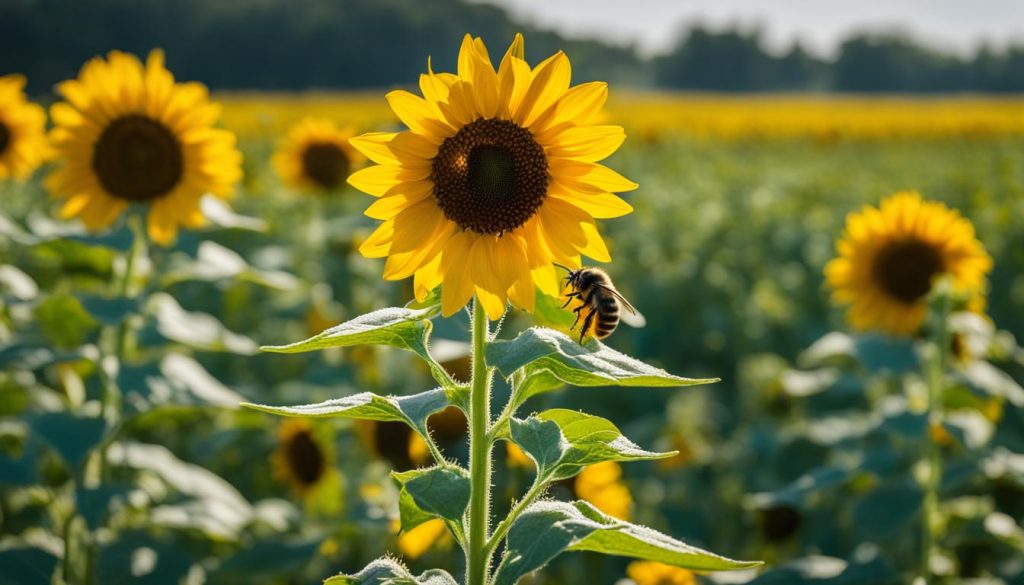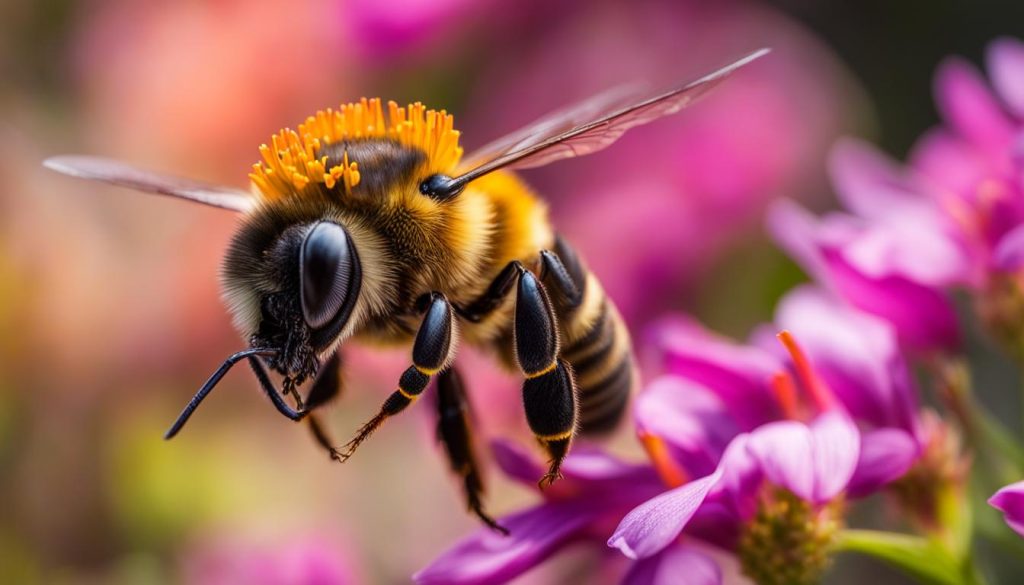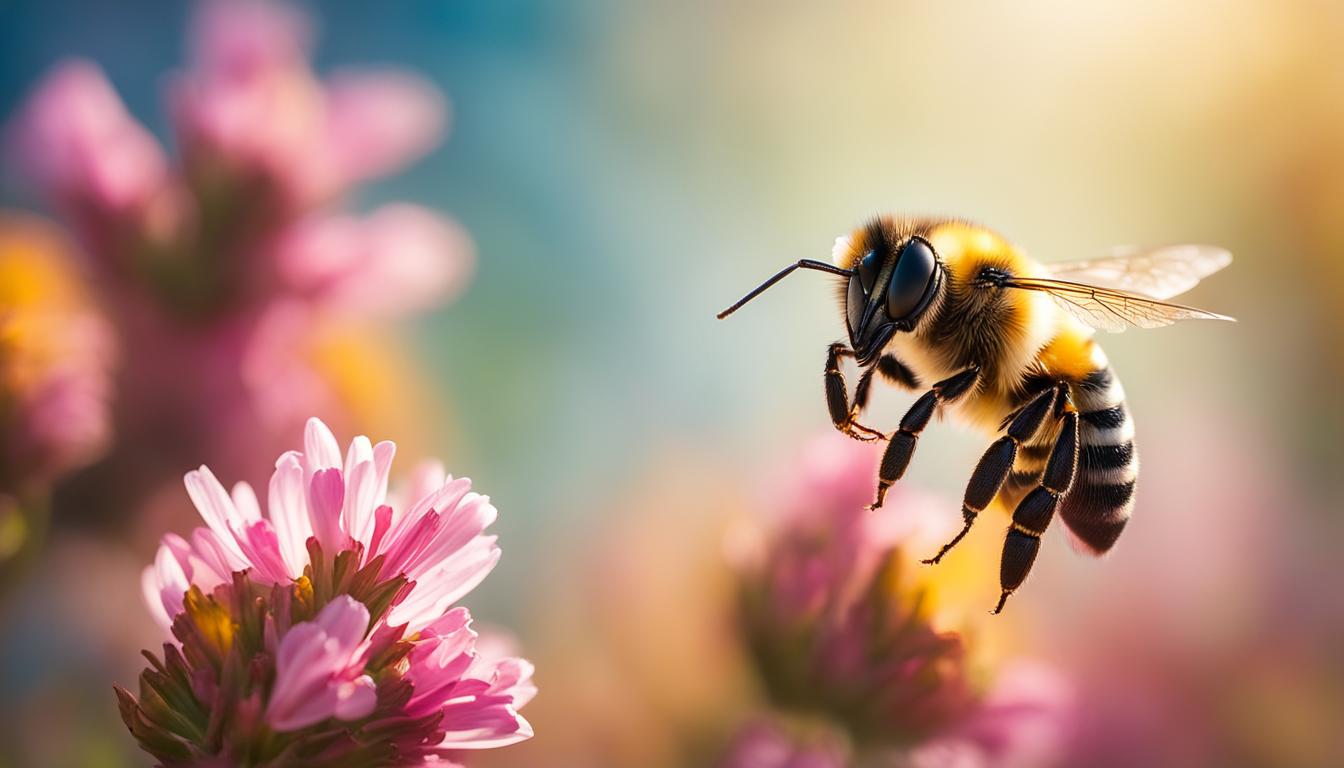Close-up bee photography is a stunning art form that allows us to witness the intricate beauty of these small creatures up close. By capturing the details, colors, and textures of bees, photographers can showcase the incredible beauty that exists within these tiny insects. One such photographer, Josh Forwood, has gained recognition for his mesmerizing close-up bee photography, which he shares on his Instagram.
Key Takeaways:
- Bee photography allows us to appreciate the intricate beauty of bees up close.
- Close-up photography showcases the details, colors, and textures of bees.
- Photographer Josh Forwood is known for his mesmerizing close-up bee photography.
- Through photography, we can raise awareness about the beauty and importance of bees.
- Close-up bee photography inspires us to protect and appreciate the wonders of nature.
Exploring Native Bee Species in the United States
Clay Bolt, a photographer, has dedicated himself to capturing the beauty of native bee species in the United States. With over 4,000 native bee species in the country, Bolt’s project, Beautiful Bees, aims to shed light on these often overlooked creatures. While the European honeybee is well-known, Bolt’s photographs highlight the diversity and importance of our native bees, which contribute billions of dollars to the U.S. economy each year.
Native bee species play a crucial role in pollination, aiding in the reproduction of plants and the production of fruits and seeds. However, many people are unaware of the incredible variety of native bees that exist in the United States. By showcasing these beautiful creatures through his photography, Bolt hopes to raise awareness about the importance of native bees and their impact on our ecosystems.
Through the Beautiful Bees project, Bolt captures the unique characteristics of each native bee species, highlighting their vibrant colors, intricate patterns, and fascinating behaviors. Each photograph is a window into the world of these remarkable insects, showcasing their beauty and highlighting their role as pollinators.
In addition to their ecological significance, native bees also contribute to the U.S. economy through their pollination services. According to a study by the University of California, native bees provide an estimated $3 billion worth of pollination services annually, benefiting crops such as almonds, blueberries, cucumbers, and squash. By photographing and raising awareness about native bees, Bolt aims to cultivate a deeper appreciation for these essential creatures and foster a sense of stewardship towards their habitats.
The Threats Faced by Native Bee Species
Despite their importance, native bee species face numerous threats that jeopardize their survival. Habitat loss, pesticide use, climate change, and diseases have all contributed to the decline of native bee populations. The Beautiful Bees project not only highlights the beauty of these creatures but also serves as a reminder of the urgent need to protect their habitats and conserve their populations.
By showcasing the stunning diversity of native bee species in the United States, Bolt’s photography instills a sense of wonder and appreciation for the natural world. Through his artistry, he hopes to inspire others to take action to protect and conserve these beautiful bees and their habitats for future generations.
The Role of Native Bees in Agriculture
Honeybees may receive most of the credit as the primary pollinators in agriculture, but experts are increasingly recognizing the vital role that native bees play in food production. Native bees, such as bumblebees and mason bees, exhibit distinct behaviors and preferences when it comes to pollinating crops. By understanding and promoting the use of native bees as pollinators, we can enhance biodiversity and improve the effectiveness of European honeybees.
Unlike honeybees, native bees are often more efficient and effective in pollinating specific crops due to their unique behaviors and adaptations. For example, bumblebees are excellent at pollinating tomatoes, blueberries, and cranberries because they use a buzzing technique called “buzz pollination” to release the pollen from these plants. Mason bees, on the other hand, are proficient pollinators of orchard crops like apples, cherries, and almonds.
“By capitalizing on the strengths of native bees, we can diversify our crop pollination strategies and reduce our reliance on European honeybees,” says Dr. Jane Parker, a leading researcher in pollination ecology. “This diversity not only promotes the health and productivity of agricultural systems but also safeguards against the potential risks associated with honeybee declines.”
“Native bees are nature’s unsung heroes in agriculture,” says Clay Bolt, the renowned photographer behind the Beautiful Bees project. “By documenting and showcasing these incredible pollinators, we hope to raise awareness about their crucial role and inspire people to protect and support their habitats.”
Native bees contribute to the pollination of numerous crops, including fruits, vegetables, nuts, and seeds. According to the U.S. Department of Agriculture, native bee pollination adds an estimated $3 billion to $14 billion in value to agricultural crops each year. Their unique behaviors, combined with their ability to thrive in diverse habitats, make them valuable partners in agriculture.

| Native Bee Species | Main Crop Pollinated |
|---|---|
| Bumblebees | Tomatoes, blueberries, cranberries |
| Mason bees | Apples, cherries, almonds |
| Squash bees | Squash, pumpkins, zucchini |
| Leafcutter bees | Alfalfa, onions, carrots |
| Sweat bees | Watermelons, cucumbers, strawberries |
As we continue to explore the world of native bees, it becomes evident that they are essential for the sustainability and resilience of our agricultural systems. By appreciating their crucial role in pollination and taking steps to support their habitats, we can foster a healthier and more productive environment for both bees and crops.
Capturing the Wonder of Bees through Photography
Photographers like Josh Forwood and Clay Bolt possess a unique talent for capturing the wonder of bees through their remarkable photography skills. By employing close-up techniques and utilizing special lighting setups, they are able to showcase the extraordinary forms and vibrant colors of these tiny creatures. Through their lens, they bring to light the mesmerizing beauty that exists within the world of bees, inviting viewers to appreciate and protect the wonders of nature.
With a keen eye for detail, these photographers artfully capture the intricate patterns, delicate textures, and fascinating behaviors of bees. Each photograph serves as a testament to the diversity and complexity of these amazing creatures. By highlighting their beauty, Forwood and Bolt hope to inspire a deep connection with nature and encourage a sense of responsibility to protect the delicate ecosystems that bees contribute to.
Bees, in their various species and forms, play a crucial role in our natural world. As essential pollinators, they contribute to the reproduction of flowering plants and the production of the food we rely on. Through their stunning imagery, Forwood and Bolt remind us of the interconnectedness of all living things, underscoring the importance of preserving the habitats that sustain these vital creatures.
Appreciating the Beauty of Nature
Through their lens, Forwood and Bolt offer us a glimpse into the hidden world of bees, revealing the intricate wonders that can easily go unnoticed. Their captivating images not only showcase the beauty of bees, but also serve as a powerful reminder of the broader beauty of nature itself. From the vibrant colors of blooming flowers to the delicate dance of a bee collecting nectar, their photography invites us to pause, appreciate, and protect the natural wonders that surround us.
These inspiring photographers strive to create awareness and cultivate a deeper understanding of the importance of bees in our ecosystem. By capturing the extraordinary details of these tiny creatures, they bridge the gap between humans and the delicate world of nature. Their work serves as a call to action, urging us to cherish and preserve the beauty of nature for future generations.
The wonder of bee photography lies in its ability to transport us into a world that is often overlooked in our busy lives. It allows us to witness the incredible diversity and complexity of these small creatures, highlighting the beauty that can be found in even the tiniest corner of our natural world.
The Beauty of Bees through the Lens
| Photographer | Photography Style | Focus |
|---|---|---|
| Josh Forwood | Macro Photography | Close-up details, vibrant colors |
| Clay Bolt | Documentary Photography | Native bee species, ecological importance |
The Challenges of Bee Photography
Photographing bees presents unique challenges that require photographers to employ specialized techniques in order to capture the intricate details of these small creatures. Bee photography enthusiasts like Clay Bolt understand the difficulties associated with capturing the beauty and essence of bees through their lenses.
One of the primary challenges bee photographers face is the small size of these insects. Bees can be as tiny as a few millimeters, making it essential for photographers to have the right equipment and techniques to capture their delicate features. To overcome this challenge, photographers often rely on macro lenses that allow them to magnify and capture the smallest intricacies of bees, such as the texture of their wings or the hairs on their bodies.
The fast movements of bees pose another challenge for photographers. Bees are constantly on the move, making it difficult to capture them in a focused and sharp manner. To address this challenge, photographers utilize techniques such as high shutter speeds and continuous shooting modes to increase the chances of capturing clear and detailed images. Additionally, some photographers may experiment with different focusing techniques, such as manual focus or using single-point autofocus, to maintain control over the focus and sharpen the desired elements.
In order to emphasize the details of bees and create visually appealing photographs, photographers often use techniques like isolating the subject against a plain white background. This technique allows the viewer to focus solely on the intricate details of the bee, creating a captivating visual experience. Additionally, off-camera flash can be used to fill in shadows and highlight the textures and colors of the bee, adding depth and dimension to the photograph.
It is worth noting that bee photographers prioritize the well-being and safety of the bees during the photography process. They work quickly and carefully to minimize any disruption or stress on the bees, ensuring that their actions do not harm these essential pollinators.
“Bee photography is a unique art that requires patience, technical skill, and a deep appreciation for these incredible creatures. It is the challenge of capturing the delicate details and fleeting moments that makes it all the more rewarding.” – Clay Bolt
Despite the challenges, the reward of bee photography lies in the mesmerizing glimpse it offers into the world of bees. The resulting photographs not only celebrate the beauty of these incredible creatures but also serve as a medium to raise awareness about their importance in our ecosystem.
Tips for Overcoming Bee Photography Challenges:
- Invest in a macro lens to capture the intricate details of bees.
- Use high shutter speeds and continuous shooting modes to freeze the fast movements of bees.
- Experiment with different focusing techniques to ensure sharpness.
- Create a plain white background to emphasize the details of the bee.
- Utilize off-camera flash to fill in shadows and enhance textures.
- Ensure the well-being and safety of bees during the photography process.

| Challenge | Technique |
|---|---|
| Small size of bees | Use macro lenses to magnify and capture tiny details. |
| Fast movements of bees | Employ high shutter speeds and continuous shooting modes. |
| Emphasizing details | Create a white background and utilize off-camera flash. |
Conclusion
Close-up bee photography offers a unique glimpse into the intricate beauty of these remarkable creatures. Photographers like Josh Forwood and Clay Bolt have dedicated their talents to capturing the wonder and diversity of bees through their art. Through showcasing the vibrant colors, delicate textures, and fascinating details of bees, they aim to raise awareness about the importance of these pollinators and inspire viewers to protect and appreciate the beauty of nature.
By zooming in on the fascinating world of bees, close-up photography allows us to appreciate the often overlooked beauty that lies within these tiny insects. The photographs captured by Forwood and Bolt serve as a powerful reminder of the incredible diversity that exists in the natural world. From the intricate patterns on their wings to the pollen-covered hairs on their bodies, these images showcase the unique and captivating aspects of bees.
The beauty of bees is not just visually captivating; it also holds immense significance for our ecosystem. Bees play a crucial role as pollinators, ensuring the reproduction of countless plant species and ultimately supporting our food supply. By shining a spotlight on these important creatures through their photography, Forwood and Bolt hope to inspire others to take action in preserving and protecting the delicate balance of our natural world.
FAQ
What is close-up bee photography?
Close-up bee photography is an art form that captures the intricate beauty of bees up close, showcasing their details, colors, and textures.
Who are some photographers known for close-up bee photography?
Josh Forwood and Clay Bolt are photographers known for their stunning close-up bee photography.
What is Beautiful Bees?
Beautiful Bees is a project by Clay Bolt that aims to shed light on the diversity and importance of native bee species in the United States.
How many native bee species are there in the United States?
There are over 4,000 native bee species in the United States.
What role do native bees play in agriculture?
Native bees, such as bumblebees and mason bees, have different behaviors and preferences when it comes to pollinating crops, making them important pollinators in agriculture.
How do photographers capture the beauty of bees through photography?
Photographers use close-up techniques, special lighting setups, and careful attention to detail to capture the extraordinary forms and colors of bees.
What challenges do photographers face when photographing bees?
Photographing bees poses challenges such as capturing their small size and fast movements, but photographers overcome these challenges through specialized techniques and careful handling of the bees.






